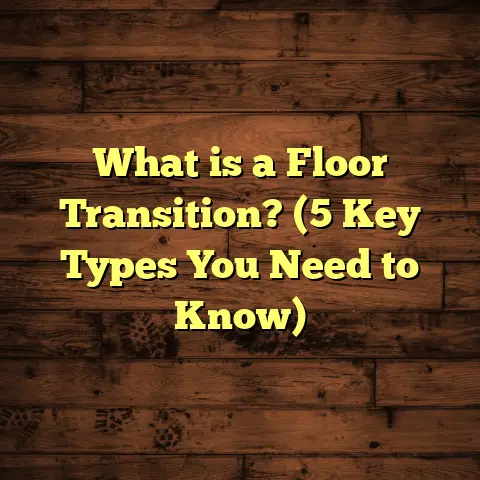What is Epoxy Flooring? (5 Benefits You Didn’t Know!)
I always find it ironic how many people look at epoxy flooring and assume it’s just a fancy paint job for concrete. When I first started in this business, that was my naive take too — just a slick, shiny surface to make floors look better. But after years of applying and seeing how epoxy performs in real-world conditions, I realized it’s way more than just eye candy. It’s a flooring system that can save you money, improve safety, handle tough conditions, and even impact your energy bills — all things most folks don’t expect.
Let me walk you through five benefits of epoxy flooring that even some contractors might miss. I’ll share my personal experiences, real data, and practical tips so you can apply these insights directly to your project.
How Epoxy Flooring Saves You Serious Money Over Time
When I started out, I used to recommend cheaper flooring options like vinyl or laminate for quick fixes. The upfront cost was low, and the floors looked decent enough. But over time, I noticed those floors degraded fast — peeling, staining, and needing replacement every few years.
Epoxy floors changed the game for my clients. While the initial price tag can be higher (typically $3 to $12 per square foot depending on thickness and finish), the lifespan and maintenance savings are incredible.
- Lifespan: Epoxy floors can last 10 to 20 years or more with proper maintenance.
- Replacement cycles: Vinyl or laminate often need replacing every 5-7 years.
- Maintenance costs: Epoxy requires cleaning with mild detergents and occasional resealing; costs average around $0.10 per square foot per year, compared to $1+ for carpet or laminate upkeep.
- Repair costs: Epoxy floors are easy to patch if damaged — often just spot sanding and recoating — whereas vinyl or laminate might require full plank replacements.
I had a warehouse client who initially balked at epoxy pricing but agreed after I showed a detailed cost comparison spreadsheet. Over 15 years, they saved over 40% compared to replacing cheaper floors twice. Plus, epoxy’s durability meant less downtime for repairs.
If you’re budgeting for your garage, basement, or commercial space, don’t just look at the sticker price — think about how long that floor will last and how much work it’ll take to keep it looking good.
Safety Perks That Surprise Even Experienced Contractors
Have you ever walked into a shop or garage where the floor looks great but you wonder if it’s safe? Slick floors can be a hazard. Here’s a story from early in my career that opened my eyes. I worked on an auto repair shop where customers kept slipping on oily patches on bare concrete. They wanted a floor that looked clean but also reduced accidents.
We applied a textured epoxy floor with aluminum oxide grit mixed in. Six months later, the shop reported a 40% drop in slip-and-fall incidents. Workers felt more confident moving around heavy equipment without worrying about losing their footing.
Here’s what I learned about epoxy and safety:
- You can customize epoxy with anti-slip aggregates like quartz sand or aluminum oxide.
- Clear topcoats with a matte finish add grip without dulling the shine.
- Some epoxies have anti-static properties useful in electronics manufacturing or flammable environments.
- Epoxy can be applied with color-coded zones or markings to guide foot traffic safely.
A lot of people assume high-gloss means slippery, but with the right additives, epoxy can be tailored for grip and traction. For businesses where safety is a priority, this is a no-brainer upgrade.
Chemical Resistance: Why Epoxy Floors Outperform Others
I’ve been called to fix floors ruined by everything from battery acid spills to paint drips. Ordinary concrete soaks up stains; vinyl delaminates under chemicals; wood warps when wet. Epoxy stands up where others fail.
Here’s some real data on chemical resistance:
- Epoxy resists most industrial chemicals for at least 72 hours without degradation.
- Food-grade epoxy variants comply with USDA standards for kitchens and food prep areas.
- Resistant to oils, gasoline, solvents, acids (within limits), alkalis, and bleach.
One of my favorite jobs was a small brewery struggling with messy spills of hops and yeast sludge. After installing an epoxy system designed for chemical and moisture resistance, their floor stayed spotless even after heavy weekly cleaning with caustic solutions.
Pro tip: If chemical exposure is part of your environment, ask your installer or supplier for lab test results showing resistance levels of the epoxy product you’re considering. Not all products perform equally.
How Epoxy Flooring Can Actually Lower Your Energy Bills
This one surprised me when a warehouse manager pointed it out after an installation. Epoxy’s glossy finish reflects light really well — which means fewer lights are needed to brighten large spaces like garages or warehouses.
Studies show reflective flooring surfaces can reduce lighting energy consumption by up to 15% in commercial buildings. This adds up quickly in places where lights run 12+ hours per day.
Beyond light reflection:
- Some epoxy formulations provide slight insulation benefits by acting as thermal barriers.
- This helps regulate concrete temperature in cooler climates, reducing heating costs modestly.
- Darker epoxies absorb heat, which can be useful in cold zones but less ideal in hot climates.
If you have a large commercial space or garage, ask about reflective epoxy finishes. The upfront cost might be slightly higher but can pay for itself through energy savings in just a few years.
Durability That Goes Beyond Scratch Resistance
Sure, epoxy resists scratches better than paint or sealers. But its real strength lies in how it bonds seamlessly with concrete and handles heavy abuse.
I once worked on a manufacturing plant floor where forklifts constantly rolled over cracks that used to spread quickly through bare concrete. After applying a 1/8-inch thick epoxy coating reinforced with quartz sand, those cracks stopped propagating. The floor stayed intact for years despite heavy daily use.
Key durability features:
- Epoxy forms a seamless surface, eliminating joints where dirt and moisture cause damage.
- Strong adhesion bonds deeply into the concrete substrate.
- Thickness can be customized — thin coats for residential garages, thick multi-layer applications for industrial floors.
- Additives like fibers or quartz boost impact resistance for tough environments.
For heavy machinery areas or spaces with frequent foot and wheel traffic, epoxy flooring is an investment in long-term reliability.
Insider Tips From My Years of Installing Epoxy Floors
I’ve learned plenty about what makes or breaks an epoxy floor job. If you want yours to last and look great:
- Preparation is king: Concrete must be clean, dry, and properly profiled (usually by grinding) before application. Dust or oils ruin adhesion.
- Pick the right product: Industrial-grade epoxy formulas differ from DIY kits or decorative versions. Match product specs to your environment — chemical resistance? UV stable? Food safe?
- Don’t skimp on thickness: Thicker coats mean better durability but also longer cure times.
- Control temperature and humidity: Epoxy cures best between 60–80°F with low humidity. Too humid? Expect bubbling or cloudy finishes.
- Regular cleaning: Use gentle detergents; avoid harsh chemicals that degrade epoxy over time.
- Seal the edges: Proper edge sealing prevents water ingress which can cause bond failure.
DIY vs Professional Epoxy Flooring: What I’ve Seen Work Best
DIY kits appeal because they’re cheaper upfront. But let me be honest — I rarely recommend them unless it’s a very small area with light use.
Why? Because:
- Surface prep tools used by pros (diamond grinders, moisture meters) aren’t typical DIY gear.
- Mixing errors happen often — wrong ratios mean soft spots or bubbles.
- Temperature control during curing is tough at home.
- Most DIY kits have thinner coatings that wear fast.
- Many DIY floors need redoing within 2–3 years; professional jobs easily last 10+ years.
If you want long-term value and peace of mind, hire a pro who can guarantee proper prep, mixing, application, and curing conditions.
A Real Garage Transformation You’ll Love
One of my favorite projects was for a family who used their garage as both workshop and hangout spot for their kids. The old floor was stained with paint spills, cracked from years of neglect—and frankly embarrassing.
We installed a metallic epoxy system with a durable clear urethane topcoat that gave depth and shine without slipperiness.
Results?
- The family loved how easy cleanup became thanks to the smooth surface.
- Oil spills wiped right off; no more stubborn stains after weeks of kids’ projects.
- The floor reflected light beautifully — brighter garage without extra bulbs.
- Slip resistance additives kept everyone safe even when kids tracked mud inside.
The best part? They called me months later to say how much more they enjoyed spending time there—and referred three neighbors immediately!
What Does the Future Hold for Epoxy Flooring?
Technology keeps pushing epoxy’s capabilities further:
- New UV-stable formulas prevent yellowing outdoors.
- Bio-based epoxies reduce environmental impact.
- Antimicrobial coatings add hygiene benefits for healthcare settings.
- Self-leveling epoxy enhances smoothness without extra labor.
I’m excited about these advances because they make epoxy more versatile than ever before — adapting to more environments while keeping its core strengths intact.
Final Thoughts From My Workshop
Epoxy flooring isn’t just about making floors shiny or tough; it’s about combining durability, safety, maintenance ease, energy efficiency, and long-term value into one solid solution. I’ve seen clients save thousands over decades thanks to its resilience.
If you’re planning a flooring upgrade for your garage, workshop, warehouse, or even your home basement—think beyond just looks. Think about how much time and money you want to spend fixing problems down the road.
I’m here if you want help figuring out if epoxy fits your space perfectly or if you want some hands-on tips for installation and care.
Would you like me to help you calculate costs or choose products tailored exactly to your needs? Just ask—I’m ready to share more insights from my years on the job.





